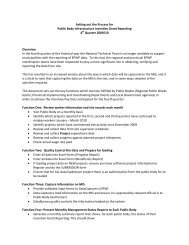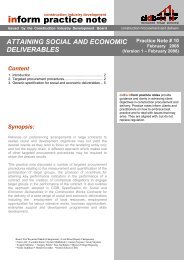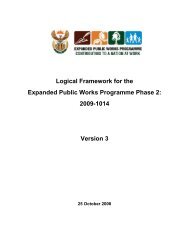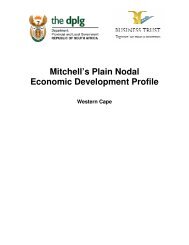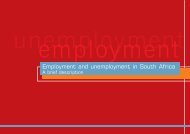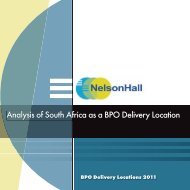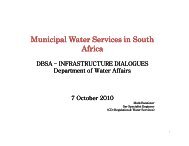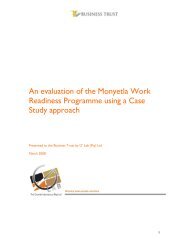National Infrastructure Maintenance Strategy - Construction Industry ...
National Infrastructure Maintenance Strategy - Construction Industry ...
National Infrastructure Maintenance Strategy - Construction Industry ...
You also want an ePaper? Increase the reach of your titles
YUMPU automatically turns print PDFs into web optimized ePapers that Google loves.
annexures<br />
Annexure A: <strong>Maintenance</strong> reviews, by sector<br />
This annexure provides the detail that is<br />
summarised in Chapter 3.<br />
The sectors are listed in the following order:<br />
• provincial roads<br />
• health and education facilities in ownership of<br />
provincial government<br />
• public buildings in ownership of national<br />
government<br />
• municipalities<br />
• water boards<br />
• water resources infrastructure in ownership of<br />
national government<br />
• ACSA<br />
• Transnet and its affiliates (principally Spoornet,<br />
<strong>National</strong> Ports Authority and SA Port<br />
Operations)<br />
• Telkom<br />
Each of these is described in the sequence:<br />
• the type of infrastructure in the care of this<br />
institution or group of institutions;<br />
• overview of the infrastructure and service<br />
delivery;<br />
• current replacement cost, if an estimate is<br />
available;<br />
• overview of state of infrastructure and state of<br />
maintenance;<br />
• what the causes of this might be;<br />
• current initiatives to enhance maintenance<br />
(both what is being promised, and what is being<br />
done); and<br />
• a short summary.<br />
All sums for "maintenance" provisions stated in<br />
this Annexure are for planned and unplanned<br />
maintenance, repair, refurbishment and renewal -<br />
but not for the eventual disposal and replacement<br />
of the infrastructure assets.<br />
All statistics represent work-in-progress and are<br />
therefore preliminary figures only.<br />
Annexure B contains generic remarks by type of<br />
infrastructure: what kinds of things go wrong if<br />
maintenance is substandard, and what is needed<br />
(descriptive, not quantity) in respect of<br />
maintenance.<br />
a. Provincial roads<br />
Overview of provincial roads departments'<br />
infrastructure and service delivery<br />
The roads departments of provincial governments<br />
are responsible for government-owned roads in<br />
their provinces that are not the responsibility of<br />
SANRAL at the one end of the scale or<br />
municipalities at the other end of the scale. Design<br />
and construction standard ranges from freeways<br />
through to unpaved roads (in 2002, 63 000 km of<br />
surfaced roads and 301 000 km of gravel and<br />
access roads ("Road infrastructure strategic<br />
framework for South Africa", DoT, 2002)). In<br />
respect of those sections of "proclaimed main<br />
roads" that traverse built-up areas, the provincial<br />
roads department could be funding or partially<br />
funding municipalities to undertake the<br />
maintenance, or they could be doing it themselves.<br />
A current replacement cost of all of the road<br />
infrastructure in the ownership of provincial<br />
governments has not been thoroughly calculated,<br />
but it is estimated to be in the order of R200 billion.<br />
State of infrastructure and state of maintenance<br />
DoT noted that all provincial roads authorities<br />
used to do annual "visual condition index" studies,<br />
but during the 10 years prior to 2002 "more than<br />
half" of them curbed or stopped doing the surveys.<br />
This is a "disturbing factor" - "some provinces have<br />
very little quality information on which to base<br />
managerial performance evaluation and needidentification<br />
processes. It seems that this could<br />
be one of the primary causes for the poor condition<br />
of the provincial road networks in general."<br />
More recent information, obtained directly from<br />
provinces, confirms that the generally downward<br />
trend in quality information and in the state of<br />
roads infrastructure is continuing. There are<br />
however some notable exceptions. More than one<br />
province still has quality information, and is able to<br />
report that its current budget levels are able to<br />
"maintain the network in its current condition",<br />
although even they are not receiving the budget<br />
that they need to significantly reduce maintenance<br />
backlogs.<br />
Study of the visual condition information available<br />
shows that almost all if not all provinces suffered a<br />
steady slide in road condition until the end of the<br />
national infrastructure maintenance strategy<br />
18



